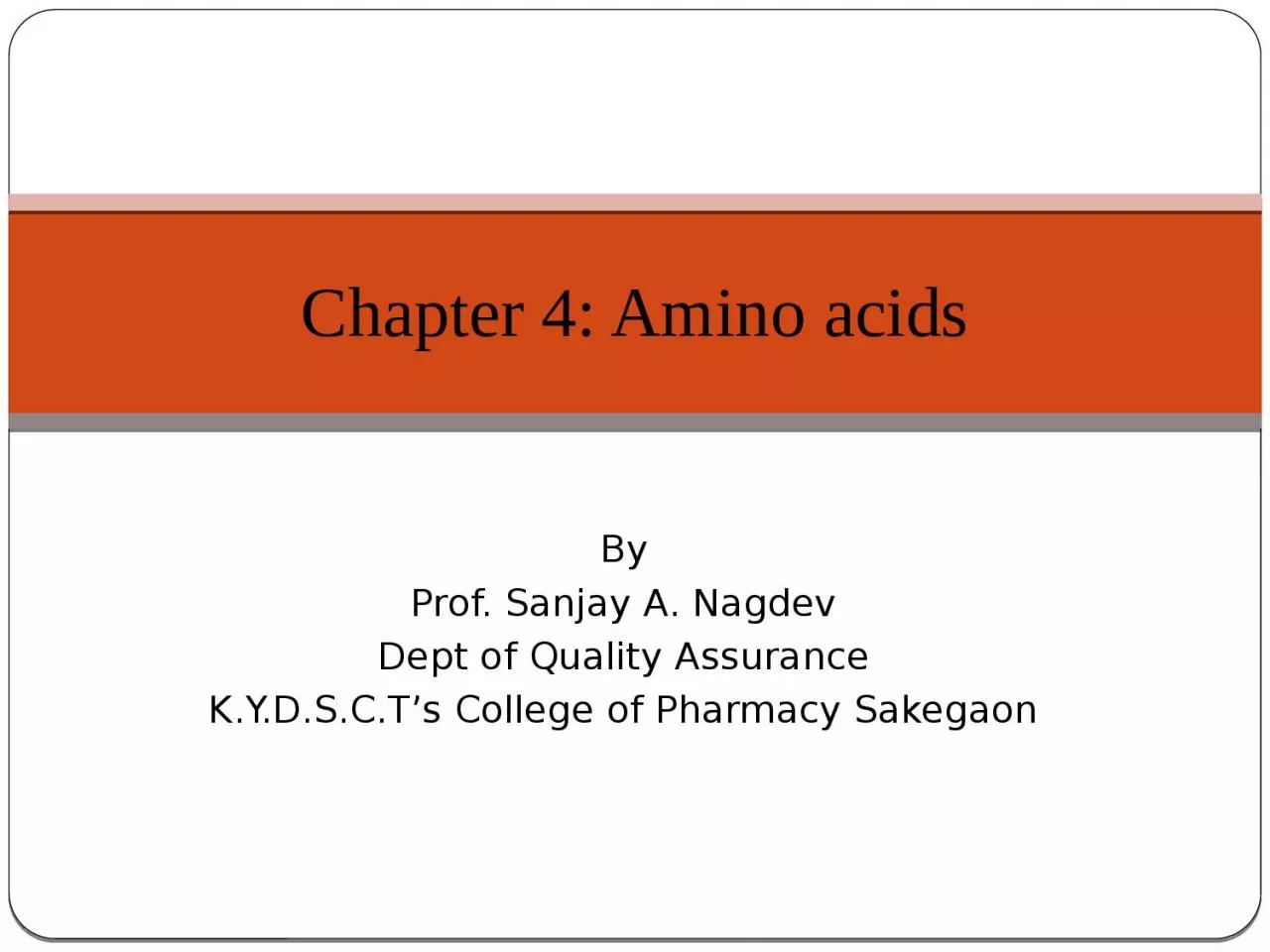

Dept of Quality Assurance KYDSCTs College of Pharmacy Sakegaon Chapter 4 Amino acids Amino acids Amino acids are a group of organic compounds containing two functional groups amino and carboxyl ID: 934848
Download Presentation The PPT/PDF document "By Prof. Sanjay A. Nagdev" is the property of its rightful owner. Permission is granted to download and print the materials on this web site for personal, non-commercial use only, and to display it on your personal computer provided you do not modify the materials and that you retain all copyright notices contained in the materials. By downloading content from our website, you accept the terms of this agreement.
Slide1
ByProf. Sanjay A. NagdevDept of Quality AssuranceK.Y.D.S.C.T’s College of Pharmacy Sakegaon
Chapter 4: Amino acids
Slide2Amino acids: Amino acids are a group of organic compounds containing two functional groups – amino and carboxyl.The amino group ( -NH2) is basic while the carboxyl group ( -COOH ) is acidic in nature.The key elements of amino acid are carbon, hydrogen, oxygen, and nitrogen.
Amino acids are the basic structural building units of protein and they are also utilized as an energy source.
There are about 300 amino acids occur in nature.
Slide3Structure of Amino acids:
Each amino acid has 4 different groups attached to α-
carbon (which
is C-atom next to COOH).
These 4 groups are : amino group, COOH, Hydrogen atom and side Chain (R)
Slide4Classification of amino acids:
1.Aliphatic amino acids
2.Hydroxyl group containing amino acids
3.Sulfur containing amino acids
4.Acidic amino acids and their amides
5.Basic amino acids
6.Aromatic amino acids
7.Imino acids
Slide51. Aliphatic amino acids:Glycine Alanine ValineLeucineIsoleucine
Glycine alanine
Slide62. Hydroxyl gr. containing amino acids (-OH):SerineThreonineTyrosine
Serine Threonine
Slide73. Sulfur containing amino acids:Cysteine Methionine
Cysteine Methionine
Slide84. Acidic amino acids and their amides:Aspartic acidAsparagine Glutamic acidGlutamine
Glutamic acid Aspartic acid
Slide95.Basic amino acids:LysineArginineHistidine
Lysine Histidine
Slide106. Aromatic amino acids:PhenylalanineTyrosine Tryptophan
Phenylalanine Tyrosine
Slide117.Imino acids : Proline containing pyrrolidine ring is a unique amino acid.
Proline
Slide12Classification of amino acids based on polarity:
1. Non – polar amino
acids:
e.g.
glycine, alanine, leucine, isoleucine, valine,
tryptophan
and proline
.
2
. Polar amino
acids
with no charge on R
group:
e.g. serine, cysteine
,
glutamine, tyrosine.
3. Polar
amino acids with positive R- group
:
e.g. lysine, arginine, histidine
4
. Polar amino acids with negative R- group
:
e.g.
aspartic acid
and glutamic
acid
Slide13Essential Amino Acids: These are the amino acids which are not synthesized in body and to be provided in the diet.Deficiency of these amino acid may cause various disease like Nerve Breakdown, inhibition of mental growth.
E.g. Valine, Leucine, Isoleucine, Threonine, Methionine, Phenylalanine, Tryptophan and lysine
Slide14Semi- essential Amino acids: These are the amino acids which are partially synthesized by the body but not in adequate amount to meet body requirement.E.g. Arginine and histidine
Non
- essential
amino acids
:
These are the amino acids which are syntesized in body
to meet
the biological needs, hence they need not
be consumed
in the diet
.
E.g.
glycine, alanine, serine,
cysteine, aspartate
, asparagine, glutamate,
glutamine, tyrosine
and proline.
Slide15The Ninhydrin Reaction
Slide16The α-amino acids react with ninhydrin to form a purple complex( Ruhemanns`s purple ).Amino acid + Ninhydrin Keto acid
+
Hydrindantin
+
NH3
+
CO
2
+
Ninhydrin
Ruhemanns’s
purple
Slide17Zwitter ion or dipolar ion : Zwitter ion is a hybrid molecule containing positive and negative ionic groups.Each amino acid has a characteristic pH at which it carries both positive and negative charges
and exists
as zwitter
ion.
Isoelectric pH:
it
is
defined as the pH at which
a molecule
exists as a zwitter ion or dipolar ion
and carries
no net charge.